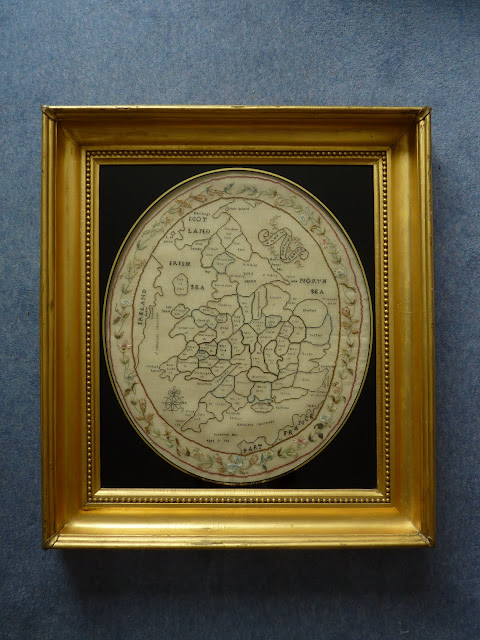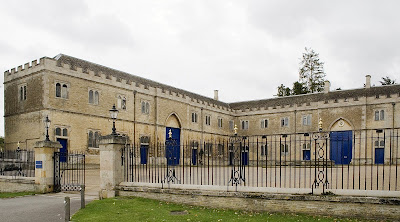Sarah YARKER - A Very Ordinary Young Lady
Sarah YARKER seemed a very ordinary young lady. She was born in 1805 in the North West of England, in Ulverston, a small market town in Cumberland, and was one of twelve children born to John YARKER and Elizabeth née KENDALL. We know little of her family background, though two of her brothers, Robert and John, became Church of England clergymen . This suggests a fairly comfortable middle-class background as the Church of England required a university degree for entry to the clergy - and in the case of her two brothers that meant Oxford. No University loans in those days! And, in an aside, her brother John had a son to whom he gave the surreal names Montague Mangles...
So why was I interested in this "ordinary young lady"? She was the focus of a story I had been researching and while doing so I wanted to learn something of Sarah's background.
She is only distantly related to me, a first cousin five times removed. I only knew of her because she is mentioned on page 21 of John YARKER's 1882 book on the Yarker family. I knew she never married, so I looked for her in the 1841 census. I had to be careful here to get the right Sarah YARKER, as there was a Sarah Jane YARKER, born in 1806, also in Ulverston. The two were first cousins and all three of us are descended from Robert YARKER 1728-1799 and Sarah HARRIS 1729-1801.
 |
| Sarah YARKER and the SWAISLAND family in the 1841 census |
[David Campbell has pointed out that this is NOT our Sarah. I have updated his information, which is much more credible, in
my next post. Meanwhile I have left my original paragraph for the sake of interest - I'm just glad that I added the note that this was "not close enough to satisfy
The Genealogical Proof Standard"!]
Well, I found what looked like our Sarah in the 1841 census, but she was in Clerkenwell, London rather than the North West of England. She was living in the household of a mathematical instrument maker, James SWAISLAND, and his family.She was described as "Sarah Yarker, 35, dressmaker, n[ot born in county]". I was pretty sure that this was not Sarah Jane YARKER as Sarah Jane appears in the 1841 census as Sarah J. YARKER and still living in Ulverston with her father and siblings. But what was our Sarah doing at the other end of the country from Ulverston? Was this really our Sarah?
I left it at this stage for some years while I got on with other research. Finally I got an opportunity to review the data and found that James SWAISLAND had married an Elizabeth YARKER at St Ann, Blackfriars in the City of London in 1821. I next found James and Elizabeth in the 1851 census - Elizabeth's age was given as 50 and her place of birth Keswick in Cumberland. That sounded hopeful. Our Sarah had a sister Elizabeth, born in March 1803 and baptised in Ulverston which is about 35 miles away from Keswick. Not a perfect match, but close. Not close enough to satisfy
The Genealogical Proof Standard but close enough for me to be pretty confident that Sarah was living with her sister and her in-laws.
Sheerness
That gives us a little background on Sarah. We now move forward a couple of years in time and fifty or so miles in distance to get to the next part of the story.
It is Wednesday 12 July 1843. Sarah and a small party are on board HMS Camperdown. About the Camperdown; four ships of the Royal Navy have carried that name, after the Battle of Camperdown in 1797. Sarah and her group are on board the second Camperdown, a 106-gun first-rate fully-rigged sailing ship of the line, 2,400 tons, built in Chatham Dock and launched in 1820 as HMS Trafalgar. She was renamed HMS Camperdown in 1825, was used for harbour service from 1854 and became a coal hulk in 1857. She was renamed HMS Pitt in 1882 and sold in 1906. So far, so unexceptional. No dramatic sea battles here. Just don't confuse this Camperdown with the third ship of that name, an Admiral-class battleship launched in 1885.
That Camperdown was involved in the notorious collision with HMS Victoria in 1893 in which over 300 lives were lost.
On this day HMS Camperdown is berthed in Sheerness Royal Naval Dockyard. The dockyard, built at the instigation of the famous diarist Samuel Pepys, lies on the north west of the Isle of Sheppey, at the mouth of the river Medway. Almost half a century before Sarah stands here, it had been the scene of the Nore mutiny - over twenty of the mutineers were hanged at the yardarm here after the mutiny collapsed. Since then the dockyard has been largely rebuilt and expanded.
Sarah's little group includes Eleanor, another sister of Sarah almost ten years older than Sarah; Eleanor's husband the Rev. John BARTON; a "Miss Barton"; and a Mrs Greenhill. "Miss Barton" seems to have been Eleanor BARTON, born 28 April 1819, daughter of Miles BARTON and Mary Richardson née CHIPPENDALE. I've not found the relationship between Miles and the Rev. John BARTON. John BARTON is Rector of Eastchurch just six miles from Sheerness so will be well known locally. We don't know whether Sarah has moved from her sister Elizabeth's household in Clerkenwell or whether she is just visiting her other sister Eleanor for the occasion. Again, we don't know who Mrs Greenhill is or what is her connection to the rest of the party.
The party has gathered on the Camperdown to witness the departure of the King and Queen of the Belgians for their voyage home - and the firing of the salute as they passed. No doubt anticipation of the ceremony is high among the party and just before three in the afternoon, as the Belgian royal vessel sails past the Camperdown, the signal is given to commence firing the salute. A report in
The Times for Saturday July 15, 1843 takes up the story.
Catastrophe
"At 45 minutes past 2 p.m. this day, while a salute was being fired in honour of the King of the Belgians passing down Sea-Reach, one of the portable magazines blew up, forced the upper deck on the starboard side up, from the mizenmast [sic] as far forward as the mainmast, and knocked down nearly all the cabinet bulkheads, fore and aft, on the upper gun-deck. Scarcely a whole pane of glass is left in the ports on that deck. So great was the force that the iron horn-knee on the beam-end, at the break of the bulkhead, where the magazine exploded, was broken quite asunder. The most melancholy part is to relate the dreadful calamity that has, by the accident, befallen the visitors then on board, and a portion of the ship's company who were about that part of the ship.
"There are three seamen - namely, Samuel West (since dead), James Duke, gunner's mate, and Alfred Fennel, hurt, the two former very dangerously, the latter slightly. Lieutenant Blackmore, belonging to the Camperdown, is dangerously hurt, a large splinter having fixed itself under his jaw-bone, which cannot at present be extracted. There are two young ladies, who were visiting the ship with their friends, most dangerously wounded and burnt; there are also several other slightly wounded and burnt.
"Nearly all the officers present have received slight injuries, by splinters, and were more or less burnt in rescuing the ladies from their burning clothes, and the bulkhead boards which were blown upon them.
"As soon as the alarm had subsided, a signal was made for the fire-engines and all boats from the different ships and the dockyard; and in a very short time the new floating engine from the dockyard was alongside the Camperdown, and the fire was soon extinguished."



The Explosion's Aftermath
What followed was horrific. As
The Times reported, one of the seamen died shortly after the explosion without regaining consciousness and in the meanwhile some of the other injured had been taken by water to Melville Hospital at Chatham, about ten miles up the Medway from Sheerness.
Sarah herself was so badly burned that she could not be moved. She was found to be unconscious by the surgeon Mr Muller when he first saw her and she died two days later. The jury at her inquest was told by Mr Muller that "death proceeded from exhaustion, caused by the burning and other injuries, producing a concussion of the brain." We do not know whether Sarah recovered consciousness, but if so the pain may have been eased by the primitive pain management then available - probably laudanum or alcohol. A week later "Miss Barton" also died after "lingering in the most distressing and painful condition until about 6 o'clock on Saturday evening, when she expired."
 |
| Portion of Sarah YARKER's death certificate |
A few days later separate inquests were held on held on the dead seaman (on Saturday 15 July), Sarah (on Monday 17 July) and "Miss Barton" (on Monday 24 July). No cause was ever determined for the explosion and at Sarah's inquest the jury was told that the standard procedure followed on this occasion was the same as had been followed on previous occasions - including between twenty and thirty salutes in the previous year. Indeed, there had been a salute fired for the return of HMS Howe just the day before, according to a report in
The Times a week later.
The same verdict of "accidental death" was returned by each of the juries.
Sarah's death was certainly in stark contrast to the previously comfortable life suggested by the description of her as "gentlewoman" on her death certificate.
"Life is a question and death is the answer."
Luis Arjona









